
L: Covid Grief ; R: Mantis

L: Covid Grief ; R: Mantis
Guided by her love for the environment, Labonie Roy has been drawing and painting all things nature for as long as she can remember. ‘My mother still has drawings of ants I made when I was four or five years old,’ she shares. For her, art is a way of learning about the world and engaging with it. She hopes it helps others do the same with her vibrant and deeply informative illustrations, whether on environmental conservation or mental health conversations. Based out of Bangalore, she has worked as an educator for a few years now and is currently working as a full-time mixed-media illustrator. The Break of Dawn, a novel on the revolt of 1857 written by Khan Mahboob Tarzi and translated by Ali Khan Mahmudabad, was published by Penguin Random House earlier this year and is her first illustrated book.
We talk to her about her journey as an illustrator, what inspires her, the process of making the book, and more.
How did your journey as an illustrator begin?
I was never formally trained in the visual arts, but I have always used art as a way to understand and explore the world better. In school, I was really interested in biology, anatomy and physiology, so I would make very detailed paintings of the respiratory system, circulatory system and so on — that is how I understood them. In retrospect, that is where illustrating began for me. Of course at the time I didn’t really see it as that. I took a couple of classes in college, but it was never the plan to get into this field. Art was just something I took refuge in, something that made me happy. In college I did my thesis on waste management and became interested in mixed-media because I was using waste that I generated to create art. Art became a lens through which I could explore a variety of issues in detail like gender, sexuality, policy, environment, mental health, biology.
After college, I worked as an educator at a wonderful organization called SowGood Farming, where I engaged kids in nature and farming through art and craft workshops. After SowGood I worked with the Nature Conservation Foundation, where I was creating resources for teachers and schools through a design research perspective. While working with experienced educators, my interest in nature conservation, mental health, education, and art all came together. I am now freelancing full-time as an illustrator and just making art that allows me to engage with the world in various creative ways.

L: Birds and Beaks
R: Spider
Do you have a personal style of illustration? What do you draw inspiration from?
A lot of this is looking back in retrospect. The biggest influences on my style were children’s books that I read, of course Roald Dahl’s books illustrated by Quentin Blake being among them, along with old science encyclopaedias. I think the way in which the graphics break things down for children to understand, makes them the most brilliant form of art. Continuing with education awareness-based art on nature, conservation and ecology, I have now started doing projects on mental health as well. All this requires you to be conscious of the audience that you are creating for, so my style varies.
The main influence has again been my interest in the environment. I collect my waste in my house and I use that to make art. Whatever I have around me will dictate what I’m making. For the book that was the idea.
The Break of Dawn is a fascinating book. How did it come about and what was the process like?
The book was my first project ever. I know that’s strange because it just came out this year, but the process of the book was initiated a couple of years ago while I was still in college. I showed Ali some of my work and we got to talking about the project. But it took some time for it all to come together. I have been experimenting with styles and working on it since 2017. It was a wonderful research process. A lot of my work is based on real settings and real people, and I want to be representative. When I am creating art that I want people to see, I want them to see themselves in it. I want them to see spaces they recognize. A lot of us have grown up on books that were illustrated by and starred white people and cultures from the West. In recent years, there has been a huge and wonderful resurgence of illustration depicting Indian people and our context, so that when you see illustrations you see yourself in them. I wanted to take that forward and show spaces and places that are familiar. Early on, I went on a research trip to Lucknow to explore the places the book is set in, see the residency, and photograph them.
At the time, since I’m also very fascinated by history, I was really interested in miniatures. I love the three-fourth perspective that miniatures have of people. There was so much detail poured into these artworks. This is a black and white project, so I couldn’t get into the colors, but I wanted to make it visually interesting. The idea was to use cloth and textures that we recognize. I used a lot of leftover scraps of cloth from my tailor and Urdu newspapers that Ali sent me from Lucknow. The rest was based on photographs I took on the trip and real textures were added in. The process allowed me to use my instincts and knowledge of history, along with Ali’s vast historical and contextual knowledge to build this visual language.
The book was the fruit of years of research and work. Has working on it impacted your process?
The book being published was an exciting step to take towards print. The purpose of my art is to make any topic exciting and interesting for anyone. In the last year, I have gone back to children’s books because this book made me think about how I could revisit print. Illustration doesn’t have to be a pretty accompaniment to text; they are units of information in themselves. They not only show you what the artist wants you to see, but through what you see in the image, the visual becomes embedded in your life.
What does the future look like for you?
I have been working on something I am really passionate about with Journey Matters. We are creating a resource that helps children articulate their feelings through A-Z cards, which have a different socio-emotional learning word on each. After working with children in government schools, and especially with the mental health epidemic that the past year has witnessed, creating art that allows children to understand how they feel is a cause I really care about. We need to inculcate self-care practices early on and art is a great learning tool for it because it allows you to interpret things and see layers which are completely dependent on your experiences.
The Break of Dawn nudged me towards the world of writing and working on more books. Personally, at any given moment, I have at least ten different children’s stories written out or even short stories for adults, and that is something I definitely want to spend more time doing. I see art as an education — art helps me explore different topics, themes and subjects, the wider the better, and that’s where I see my art taking me.
Text Shreeja Sen
Date 21-09-2021